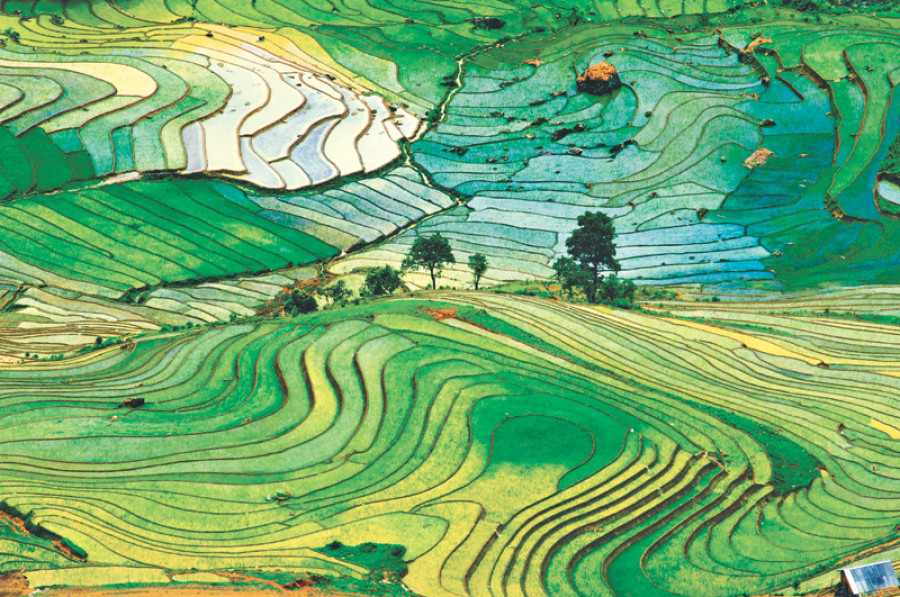Miscellaneous
The harvest of sorrow
The story of Marie Antoinette adding fuel to the fire of the French Revolution by telling hungry peasants to eat cake if they have no bread left might be an apocryphal one.
Abhinawa Devkota
The story of Marie Antoinette adding fuel to the fire of the French Revolution by telling hungry peasants to eat cake if they have no bread left might be an apocryphal one. But there is enough evidence to suggest that rising wheat prices, coupled with reduced food subsidy, were crucial to the spread of the Arab Spring, a wave of protests and demonstrations that erupted across the Middle East around six years ago.
What started as a self-immolation carried out by a vegetable vendor in rural Tunisia to protest a public humiliation he had to face while trying to earn his livelihood quickly spread throughout the pan-Arab world and its surroundings, gaining sympathisers and toppling dictators in its wake.
While it is well known that conflict decreases food production and can lead to hunger, instances that validate the opposite are also equally apparent, ie, scarcity of food or the difficulty of accessing it in sufficient quantities can jeopardise social stability and sow the seed of conflict.
The Arab Spring is a good case in point. So is the Maoist revolution. The far-and mid-western districts of Nepal, which occupied the centre stage during the Maoist insurgency, are at the bottom of livelihood and food securities. And although the revolution has come to an end, the situation has not changed for better. A 2013 report by the US government’s Global Hunger and Food Security Initiative, for example, says that two-thirds of Nepali people suffer from food insecurity each year.
Geography aside, Nepal owes its dwindling food production, after accounting for population growth, to various structural and economic deficiencies, most of which have been comprehensively discussed in Food Security in Post-conflict Nepal, edited by Bishnu Raj Upreti, Sagar Raj Sharma and Suman Babu Paudel.

Gender discrimination further exacerbates food security issues. The priority males are given in our culture vis-à-vis females and the restrictions imposed on the latter, especially regarding their participation in economic activities, affects food availability for girls and women, mostly those living in rural areas. This means that they consistently fare worse than males in hunger, malnutrition and food security indices.
Other challenges have recently cropped up. Nepal’s temperature is said to be rising faster than the global average. Given that the monsoon plays a pivotal role in the country’s agriculture (which many point out is a result of lack of investment on irrigation infrastructure), changes in the rainfall pattern and fluctuations in temperature have led to a decline in productivity in some areas and famine and droughts in others.
Similarly, the writers argue that the rise of multinational agribusiness corporations like Monsanto and Syngenta could spell doom for the already impoverished lot in countries like Nepal. Monopolising plant genetic resources and trading them as lucrative commodities has come at the cost of tens of millions of farmers around the world for whom seeds were and still are a part of their communal heirloom and carry deep emotional and cultural resonances.
With big corporations wielding tremendous power globally and controlling the resource, knowledge and markets in the food chain, farmers have found themselves at the receiving end of exploitation. Though these hybrid seeds promise bumper yields and are said to be resilient to various pests, insects and the effects of climate change compared to the traditional ones, the truth seems to be something else. There is at least one documented case of Nepali farmers being duped by these companies. In 2010, farmers in Bara, Sarlahi and Rautahat districts suffered huge losses after planting genetically modified maize seeds imported from India.
There are other factors that have contributed to food insecurity in our country. We have not invested much in infrastructure projects like irrigation. Our research in plant science is insignificant and hardly of any benefit to our farmers. Similarly, with young men migrating to foreign countries to make money, agriculture has taken a backseat.
All this is not to say that there is no ray of hope amid the doom and gloom. Nepal has taken some steps to curb this problem. According to a study carried out by the FAO in 2013, Nepal has made good progress in fight against hunger and malnourishment. Also, the new Constitution treats right to food as a fundamental right and mandates the state to pursue policies to achieve food sovereignty.
But still, the writers argue, there is lot left to be done in this area. Food insecurity or even insufficiency, according to the book, in the present world is less a result of food shortage than of socio-economic and political inequalities and as such can be minimised. And it is important to do so, not just to save lives of people now, but to save our common future. A hungry population, as we know by now, is a restive population.




 11.12°C Kathmandu
11.12°C Kathmandu








%20(1).jpg&w=300&height=200)

